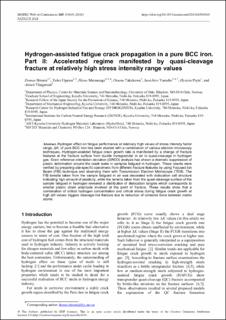| dc.contributor.author | Birenis, Domas | |
| dc.contributor.author | Ogawa, Yuhei | |
| dc.contributor.author | Matsunaga, Hisao | |
| dc.contributor.author | Takakuwa, Osamu | |
| dc.contributor.author | Yamabe, Junichiro | |
| dc.contributor.author | Prytz, Øystein | |
| dc.contributor.author | Thøgersen, Annett | |
| dc.date.accessioned | 2020-12-30T11:07:17Z | |
| dc.date.available | 2020-12-30T11:07:17Z | |
| dc.date.created | 2018-07-10T13:55:26Z | |
| dc.date.issued | 2018 | |
| dc.identifier.issn | 2261-236X | |
| dc.identifier.uri | https://hdl.handle.net/11250/2721116 | |
| dc.description.abstract | Hydrogen effect on fatigue performance at relatively high values of stress intensity factor range, ΔK, of pure BCC iron has been studied with a combination of various electron microscopy techniques. Hydrogen-assisted fatigue crack growth rate is manifested by a change of fracture features at the fracture surface from ductile transgranular in air to quasi-cleavage in hydrogen gas. Grain reference orientation deviation (GROD) analysis has shown a dramatic suppression of plastic deformation around the crack wake in samples fatigued in hydrogen. These results were verified by preparing site-specific specimens from different fracture features by using Focused Ion Beam (FIB) technique and observing them with Transmission Electron Microscope (TEM). The FIB lamella taken from the sample fatigued in air was decorated with dislocation cell structure indicating high amount of plasticity, while the lamella taken from the quasi-cleavage surface of the sample fatigued in hydrogen revealed a distribution of dislocation tangles which corresponds to smaller plastic strain amplitude involved at the point of fracture. These results show that a combination of critical hydrogen concentration and critical stress during fatigue crack growth at high ΔK values triggers cleavage-like fracture due to reduction of cohesive force between matrix atoms. | en_US |
| dc.language.iso | eng | en_US |
| dc.publisher | EDP Sciences | en_US |
| dc.rights | Navngivelse 4.0 Internasjonal | * |
| dc.rights.uri | http://creativecommons.org/licenses/by/4.0/deed.no | * |
| dc.title | Hydrogen-assisted fatigue crack propagation in a pure BCC iron. Part II: Accelerated regime manifested by quasi-cleavage fracture at relatively high stress intensity range values | en_US |
| dc.type | Peer reviewed | en_US |
| dc.type | Journal article | en_US |
| dc.description.version | publishedVersion | en_US |
| dc.rights.holder | © The Authors, published by EDP Sciences. This is an open access article distributed under the terms of the Creative Commons Attribution License 4.0 (http://creativecommons.org/licenses/by/4.0/). | en_US |
| dc.source.pagenumber | 6 | en_US |
| dc.source.volume | 165 | en_US |
| dc.source.journal | MATEC Web of Conferences | en_US |
| dc.identifier.doi | 10.1051/matecconf/201816503010 | |
| dc.identifier.cristin | 1596561 | |
| dc.relation.project | NORTEM: 197405 | en_US |
| dc.source.articlenumber | 03010 | en_US |
| cristin.unitcode | 7401,80,0,0 | |
| cristin.unitname | SINTEF Industri | |
| cristin.ispublished | true | |
| cristin.fulltext | preprint | |
| cristin.qualitycode | 1 | |

